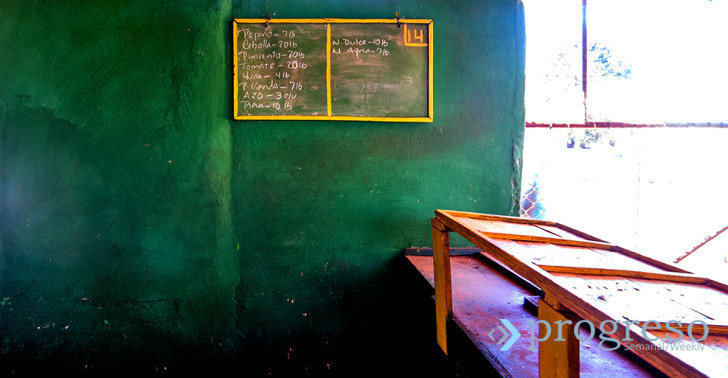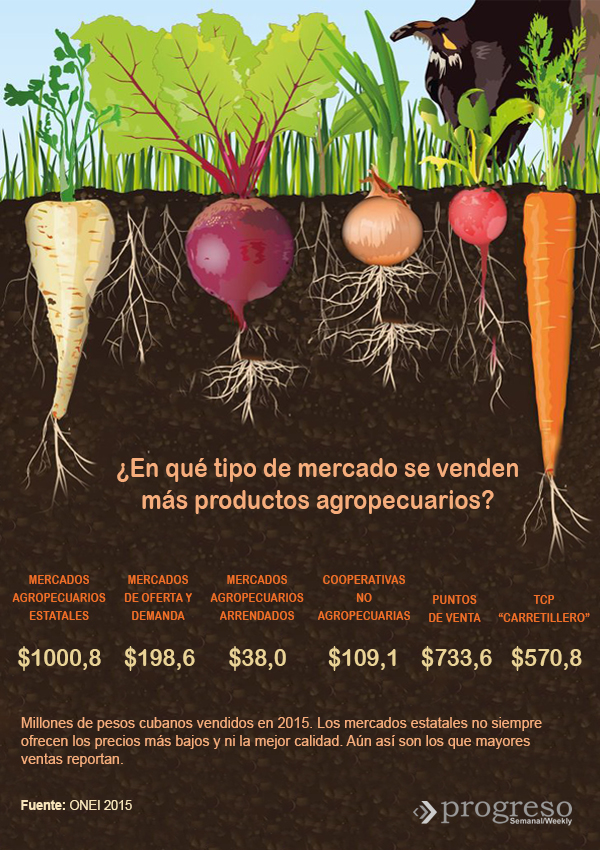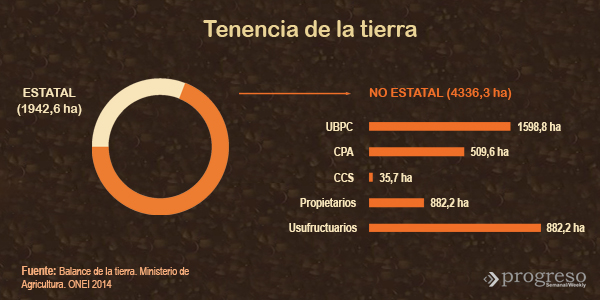
‘I charge a lot because I pay a lot’
“I charge a lot because I pay a lot.” The problems of farming and the high prices of food in Cuba are summarized in those words by a greengrocer who, though he sells directly to the consumer, refuses to lower his prices.
Because we’re talking about a nation’s food supply and, as we all know, “we don’t play with our food,” that brief phrase has serious connotations.
The high cost of food is typical of a market limited by the scant supply (low productivity), by a long and tangled chain of commercialization and production, and by the strict conditions in which farmers labor.
Some of these aspects have been widely analyzed by experts on the subject who, for years, have warned about the importance of correcting what is known to be working poorly.
This is a moment of crisis. But it is not a recent problem because, for many years, farming in Cuba has been slow to take off — and still hasn’t.

Nor are high prices something new. In fact, in the past, several efforts have been made to put a cap on them, without any positive results.
In other words, we know that this top limit on prices has not worked. Even so, in the Jan. 17 issue of the Tribuna de La Habana (and only in that newspaper, as far as we know) we learned of the expansion of the network of state-run farmers markets in Havana, supplied by farmers in Artemisa and Mayabeque provinces and governed by an official list of prices with an obligatory ceiling.
In late December 2015, some of the deputies to the National Assembly during the Sixth Session of the Eighth Legislature put this solution on the table. In view of the concern raised by the high prices of food, President Raúl Castro said that this was “a worrisome issue” that needed to be solved “momentarily, at least” but without delay.
Days later, facing the possibility that the government might impose — at least momentarily — a ceiling on the prices of various farm products, the markets in Havana became practically empty. In fact, some of them shut down.
According to La Tribuna, the producers and middlemen in the food distribution chain had heeded their leaders and taken their own measures, i.e., “concealed the merchandise to put pressure on the prices, and for that reason several operators were taken before the prosecutor’s office.”
Private producers and members of the Credit and Service Cooperatives (CCS) are an economically important group. According to the National Office of Statistics and Data, the two entities together produce 69.7 percent of the nation’s food in only 20.6 percent of arable land.
They are also responsible for 66.2 percent of the nation’s production of milk, whereas the State produces only 13 percent. They also own 66.3 percent of the dairy cows, 65.8 percent of the cattle and 57 percent of the hogs.
For this reason, the consequences of the latest measures can be as serious as the quote that began this article, so long as the largest production of food in the nation is not in the hands of the State sector. Still, it is the responsibility of the State to act and make sure that the agro market adheres as much as possible to fair competition.
Besides, we’d have to analyze the productive capability of the farms in Artemisa and Mayabeque provinces, which furnish Havana, to learn the real possibility that their supplies are “of quality” and delivered “in a permanent manner.” But those data are not available.
In this case, the producers might sell the rest of their goods to other forms of non-state commercialization, after fulfilling their contracts with the State, and the remainders might be sold at high (or higher) prices because the quantities are small.
The article in La Tribuna does not mention the volume of production to be sold to the State through those contracts. Some time ago, a producer of beef, rice, milk or potatoes had to sell an average of 80 percent of his production to the State. That changed, after the decentralization of food production, to about 51 percent.
The final objective was that the State-bought supplies could be concentrated on the social projects that the Cuban State guarantees: schools, hospitals, child-care centers, etc.
But with the recent capping of prices, we may be seeing a return to the major commitments to the State, which means a step backward for Cuban agriculture.
Even with products where the State had always played an almost monopolistic role, such as beef and milk, the prices charged to the population remained high. Why didn’t they drop earlier?
On the other hand, some Internet sites have been reporting this week on a ban on “carretilleros” (push-cart vendors). Though the ban has not been officially imposed and itinerant vendors still can be seen on the city streets, some cases have come to light.
‘Pricing is a system’
As President Castro told Minister of the Economy Marino Murillo at the National Assembly, the Cuban functionaries responsible for the agro sector were to meet on Jan. 4 to analyze those problems.
It wasn’t until last Sunday (Jan. 17) that the printed edition of Tribuna de La Habana — and no other medium — reported on the capping of prices in State-run agro markets.
Through the reports of the fewer than 10 journalists who covered the National Assembly debates, we learned that Agriculture Minister Gustavo Rodríguez Rollero told of the creation of eight organizations devoted to the improvement of entrepreneurial system in the agro sector. The reports also told of the disciplinary measures imposed on agro-sector providers.
We also heard, from the lips of Finance and Prices Minister Lina Pedraza, about some measures “intended to achieve gradual increases and greater output in agro production,” which can be translated into lower taxes and some payment exceptions for food producers.
That’s good news, considering that, in general, a heavy tax burden ends up reflected in the final price of food — astronomical numbers paid by the consumer at large.
But nothing was published (we don’t even know if anything was discussed) about the complex situation of the producers. Everything they buy is expensive: fuel, technical and organic supplies, etc.
Although the process of commercialization was decentralized by the State, in the link representing the producer (perhaps the most important link), the mechanism continues to be very strict. True, there has been some improvement. For example, the new contracts say that the producers can deliver a smaller portion of their production to the State, but the productive sector remains hampered by the nonexistence of a supplies market where farmers can find and buy what they need at the precise moment.
Let’s not forget that the agro sector deals with living organisms and animals, and nature cannot wait for the fertilizers the land needs.
In numerous publications, Prof. Armando Nova, who has researched the topic for years, has studied in detail the principal obstacles to agriculture in Cuba. To the above-mentioned obstacles could be added that, although the price of crude oil on the world market has dropped, that drop has not been totally reflected in the prices on the island.
Producers don’t even have a special price list, as do some non-agro cooperatives in the transportation sector. All this explains — though it doesn’t justify — the fact that some producers under-declare the real amounts of foodstuffs, so as not to sell their entire production for a lower price than they can get in a supply-and-demand market, as Tribuna de La Habana has reported.
That is a bad sign, to say the least. Because the State can calculate the production that reaches its hands, but the farmer has a thousand ways to not declare the total volume of his production.
On the other hand, the land is mostly in the hands of the non-State sector.

The matter of high prices is not restricted to foodstuffs. At the National Assembly, deputy Adalberto Fernández showed the relationship between the prices of agro products (“which will not fall by decree”) and the rest of the prices nationwide.
“In general, what’s happening has to do with the pricing policy that exists in all networks of commerce (240%)” he said, according to the daily Juventud Rebelde.
“If the prices of products at the Hard-currency Stores (TRD) don’t drop, if a pair of working boots continue to be so expensive, we cannot expect the price of pork, or the other products the people demand, to drop.”
That’s what most of the black-market vendors are repeating: “Take advantage of our prices, because we sell cheaper than the shopping mall.” Except that, in reality, the prices are less expensive. There’s a big difference.
Simply put, pricing is a system. In the words of numerous economists, you can’t put a price on a farm product without considering that aspect. If the State-owned stores sell milk at twice the price of the underground market, that will have a bearing on the rest of the components of the price chain.
Not dealing with the situation this way is ignoring a reality that for years has mistreated the Cuban population, because the prices keep rising.
[Photo at top by Carlos Ernesto Escalona Martí (Kako]

